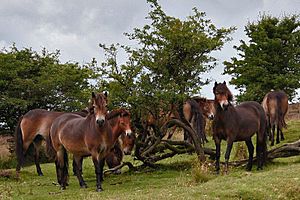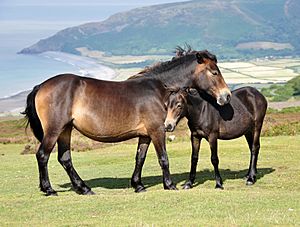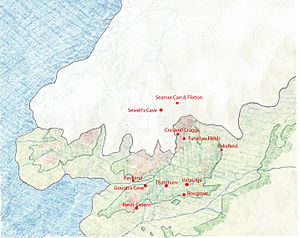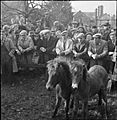Exmoor pony facts for kids
The Exmoor pony is a special type of horse that comes from the British Isles. These ponies are quite unique because some of them still live wild on Exmoor, a big area of open land in southwest England. They are known for being very tough and strong. Sadly, the Exmoor pony is an "endangered" breed, which means there aren't many left. Groups like the Rare Breeds Survival Trust are working hard to protect them. These ponies are great at living in cold weather and are used for many horse-riding activities. When they roam freely, they also help keep the natural grasslands healthy.
Contents
What Exmoor Ponies Look Like
Exmoor ponies are usually a dark brown color, often called "seal brown." They have lighter, "mealy" markings around their eyes, nose, sides, and belly. These lighter patches are called pangaré and are a natural trait found in many ancient horse breeds. To be officially recognized as an Exmoor pony, they cannot have any white markings on their body.
Most Exmoor ponies stand about 11.1 to 12.3 hands tall. A hand is a way to measure a horse's height, with one hand being four inches. So, these ponies are usually between 45 and 51 inches tall at the shoulder.
Built for Toughness
Exmoor ponies have a strong, muscular body. They are very powerful for their size and can handle difficult conditions. They have a deep chest and a wide back. Their legs are short but strong, with tough hooves that can handle rough ground.
The head of an Exmoor pony is a bit large compared to its body, and its ears are small. They have a special feature called a "toad eye." This is extra flesh around their eyelids, which helps keep water out and provides extra warmth in cold weather.
Winter Coat Wonders
Like many ponies that live in cold places, the Exmoor grows a special winter coat. This coat has two layers:
- An inner layer that is soft and woolly, which keeps them super warm.
- An outer layer of longer, oily hairs. These hairs act like a raincoat, making water run off the pony's sides instead of soaking into the warm undercoat.
Their mane and tail are also very thick and long. The top part of their tail, called the dock, has coarse hairs that form a "frost cap" or "snow chute." This helps direct rainwater away from their sensitive belly and groin areas.
Exmoor Pony History
Ancient Horse Ancestors
Some people who love Exmoor ponies believe they are directly related to wild horses from the Ice Age, more than 10,000 years ago. This would mean they have stayed pure and unchanged for a very long time.
However, modern science, using DNA research, tells us a different story. Studies show that Exmoor ponies share their DNA with many other horse breeds from all over the world. This suggests they are not as isolated or "pure" as once thought.
Even so, horses have lived in Britain for hundreds of thousands of years! Scientists have found horse bones from as far back as 700,000 BC. There's even evidence that early humans were hunting horses in the area around 500,000 BC. Horse remains have been found in caves and ancient burial sites across England, showing that horses have been a part of the landscape for a very, very long time.
Images for kids
-
Bampton Fair- Pony, Sheep and Cattle Sales in Bampton, Devon, UK, October 1943. Ponies were often sold here after gathering in the autumn.







